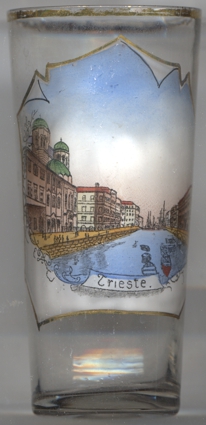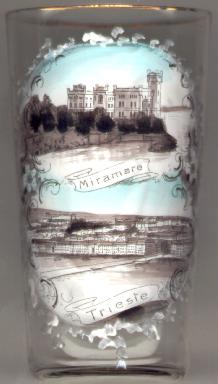

|
| ITALIA | ITALY |
| regione: Friuli - Venezia Giulia | |
| provincia: Trieste |
Trieste is located at the Gulf of Trieste of the Adriatic Sea in northeastern Italy.
By 177 BC the territory had come under control of the Roman Empire and obtained the status of a colony
under Julius Caesar. Caesar also reported its name as Tergeste in his commentarii di bello gallico
in 51 BC. In the 6th century Trieste became the seat of bishops, who later also were sovereign rulers of the territory
between 948 and 1216. In 1382 the town voluntarily put itself under the rule of the Habsburg Duke Leopold III
of Austria because it was threatened to be overwhelmed by the Republic of Venice.
Except for a period of French rule in 1809–1814, Trieste remained with Austria. In 1867 it became the
capital of the Austrian crown land Küstenland (Littoral), which also included the Duchy of Istria and the
County of Görz (Gorizia) and Gradisca (see also map
of the Austro-Hungarian Monarchy). Since 1719 Trieste had been a Free Port and had become the major sea port
of Austria. After World War I it formally became part of Italy in 1921. After World War II Trieste
was claimed by Yugoslavia because the population included a large number of Slovene-speaking people. The town
and the surrounding territory was then declared the Free Territory of Trieste in 1947. Although formally independent,
the northern part (zone A) was administered by British and US forces, while the southern part (zone B) remained
under control of the Yugoslav army. After the Treaty of Osimo in 1954 the free territory was dissolved; zone A
with Trieste became part of Italy, while zone B became part of Yugoslavia. Today, Trieste is the largest sea port
in the Adriatic Sea and is the capital of the Friuli-Venezia Giulia region of Italy. Its population is about 230,000
still including a considerable Slovene minority.

The  Piazza della Borsa [left]
is named for the
Piazza della Borsa [left]
is named for the
 Palazzo
Palazzo Palazzo
Palazzo
The centre of the Piazza della Borsa is marked by the
 Colonna
Colonna

The  Municipio (Town Hall) [near left, no. 2514] is located in Piazza Unità d'Italia.
Soon after the old Mandracchio was filled in (1858–1863, the new square was designed as a wide open space directly at the sea front
surrounded by houses with the town hall as the dominant structure. The Trieste architect Giuseppe Bruni won the competition for the design in 1875.
The building is dominated by the central bell tower which houses two bells, lovingly called Micheze e Jacheze by the Triestini (Michele and Giacomo in Italian).
The two figures that strike the bell every quarter hour have been replaced by faithful copies in 2006 when the originals were moved to
the Castello di San Giusto after having be restorated. The popular nickname of the building is Palazzo Cheba or Palazzo Gabbia (Cage Palace)
because the Triestini thought it resembled a huge cage for birds.
From the central balcony Mussolini pronounced the promulgation of racial laws in Italy on 18 September 1938.
Municipio (Town Hall) [near left, no. 2514] is located in Piazza Unità d'Italia.
Soon after the old Mandracchio was filled in (1858–1863, the new square was designed as a wide open space directly at the sea front
surrounded by houses with the town hall as the dominant structure. The Trieste architect Giuseppe Bruni won the competition for the design in 1875.
The building is dominated by the central bell tower which houses two bells, lovingly called Micheze e Jacheze by the Triestini (Michele and Giacomo in Italian).
The two figures that strike the bell every quarter hour have been replaced by faithful copies in 2006 when the originals were moved to
the Castello di San Giusto after having be restorated. The popular nickname of the building is Palazzo Cheba or Palazzo Gabbia (Cage Palace)
because the Triestini thought it resembled a huge cage for birds.
From the central balcony Mussolini pronounced the promulgation of racial laws in Italy on 18 September 1938.


Glasses no. 4523 [left], no. 4742 [right] and no. 4325 [below] show views of the
 Canal Grande
Canal Grande
The  church of Sant'Antonio Taumaturgo [near left, no. 4523: background], commonly known as
Sant'Antonio Nuovo, is located in the eponymous square at the end of the Canal Grande. It is the main religious building in the Borgo Teresiano in the
centre of Trieste as well as the city's largest Catholic church. Until the middle of the eighteenth century, a private chapel dedicated to the Annunciation
stood on the site of the present church. After having been opened to the public, the great number of worshippers soon made the space inadequate. As a result,
it was decided to build a new church dedicated to Saint Anthony of Padua (in Italian often referred to as Taumaturgo, i.e. the miracle worker. The
structure was completed in 1771 but fairly soon it became clear that this building in turn was too small. The project for the current, Neoclassical church dates
back to 1808, but work only began in 1825/1827. The building, designed by the Swiss architect Pietro Nobile was completed in 1849. The church originally stood
at the end of the Canal Grande, but in 1934 the end section of the waterway was filled in, separating it from the church and allowing room for a new road.
church of Sant'Antonio Taumaturgo [near left, no. 4523: background], commonly known as
Sant'Antonio Nuovo, is located in the eponymous square at the end of the Canal Grande. It is the main religious building in the Borgo Teresiano in the
centre of Trieste as well as the city's largest Catholic church. Until the middle of the eighteenth century, a private chapel dedicated to the Annunciation
stood on the site of the present church. After having been opened to the public, the great number of worshippers soon made the space inadequate. As a result,
it was decided to build a new church dedicated to Saint Anthony of Padua (in Italian often referred to as Taumaturgo, i.e. the miracle worker. The
structure was completed in 1771 but fairly soon it became clear that this building in turn was too small. The project for the current, Neoclassical church dates
back to 1808, but work only began in 1825/1827. The building, designed by the Swiss architect Pietro Nobile was completed in 1849. The church originally stood
at the end of the Canal Grande, but in 1934 the end section of the waterway was filled in, separating it from the church and allowing room for a new road.

The  church of the Most Holy Trinity and St. Spyridon (Santissima Trinità e San Spiridione) [near left,
no. 4325: far left] (in Serbian: Црква Свете Тројице и
Светог Спириидона) is the church of the Serbian-Orthodox of Trieste. It was built in
1861–1866 by the architect Carlo Maciachini. The church community is one of the largest serbian-orthodox communities in Italy. Since 2010
it is part of the Serbian Orthodox Eparchy of Austria and Switzerland.
church of the Most Holy Trinity and St. Spyridon (Santissima Trinità e San Spiridione) [near left,
no. 4325: far left] (in Serbian: Црква Свете Тројице и
Светог Спириидона) is the church of the Serbian-Orthodox of Trieste. It was built in
1861–1866 by the architect Carlo Maciachini. The church community is one of the largest serbian-orthodox communities in Italy. Since 2010
it is part of the Serbian Orthodox Eparchy of Austria and Switzerland.
[https://www.discover-trieste.it/code/15371/Canal-Grande;
https://en.wikipedia.org/wiki/Sant%27Antonio_Taumaturgo,_Trieste;
https://de.wikipedia.org/wiki/Kirche_der_Dreifaltigkeit_und_des_Hl._Spyridon_(Triest)]


One of the most important tourist attractions of Trieste is the
 Castello
Castello
Maximilian was trained for the navy and became
instrumental for the creation of the naval port of Trieste. From 1857 until the loss of Lombardy in 1859
he was regent in Milan. After that he retired to private life and mostly lived at Miramare castle.
Although he resisted at first, he was proclaimed Emperor of Mexico with the backing of Napoleon III
of France on the 10th of April 1864. During the Maxican Revolution, Maximilian was imprisoned by the
Mexican Republican forces and was executed at Querétaro on the 19th of June 1867.

Between 1931 and 1936 the castle was the home of Amedeo of Savoy, the 3rd Duke of Aosta. Amedeo became viceroy of Ethiopia in 1937 but was imprisoned by the British in 1941 and died during his imprisonment in 1942.
Since 1950 Miramare castle is open to the public as a museum.


![[scale]](lineal.jpg)